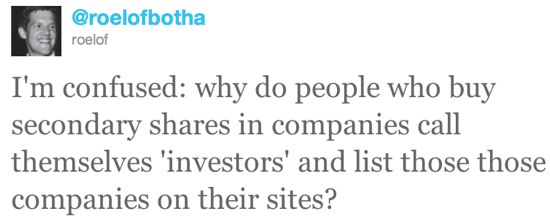
I first wrote about Inspirato (affiliate link, see below) earlier this year – it’s a way for people to rent high end vacation homes at extremely reasonable prices. Instead of paying $4,000 a night for a four bedroom penthouse condo on the beach in Puerto Vallarta (with a private pool, no less), for example, you can pay just $400/night with Inspirato.
The picture above is a 2 bedroom, 3,200 square foot home in Tuscany that rents for $450/night in the summer, and as low as $320 per night in the off season.
For families, or a bunch of friends, it’s an extremely inexpensive way to feel like you are a super high roller while you’re on vacation.
The company operates on a “Costco” model. They have long term leases on the properties and let members get them for a price that just covers the cost of those leases (and the cost of a concierge, housekeeping, etc.). The profits all come from a one time initiation fee of $15,000, and a $2,500 maintenance cost.
It’s not for everyone, but there are a lot of people out there that see this as an almost magical deal. In just the few months since launching they have 900 members, and are adding about 100 per month.
I’ve been thinking about joining since I first wrote about them. Now, I’m not only joining but I’m investing, too. CrunchFund is joining the $17.5 million venture round being led by Kleiner Perkins.
If you’d like to join, use this affiliate link – http://www.inspirato.com/Invite/marrington. I get a $1,000 credit for each signup, and I’ll assign that to you for you to use for your first trip.
Kleiner Perkins Caufield & Byers Leads $17.5M Financing for Inspirato
Investment to fuel property expansion for world’s fastest growing destination club
DENVER, October 18, 2011 – Today, Inspirato announced $17.5 million in equity funding
led by Kleiner Perkins Caufield & Byers (KPCB), the preeminent venture capital firm for
category building consumer companies. Founded by Brent and Brad Handler, the co-
founders of Exclusive Resorts, Inspirato eliminates what is wrong with luxury vacation
rentals, adds what is right about destination clubs, and creates the perfect solution for
families wanting to vacation better. Other investors in the round include Access Venture
Partners and New York Yankees All-Star First Baseman Mark Teixeira.
Launched in January of 2011, Inspirato’s quickly expanding property portfolio has over
85 residences in 25 destinations. With more than 900 memberships sold to date, Inspirato
is already cash flow positive and plans to use the new capital to add even more vacation
choices for its members.
“KPCB’s investment in Inspirato offers further proof that ‘smart luxury’ is alive and well,
and that savvy consumers are looking for a better way to vacation with family and friends,”
said Inspirato founder and CEO Brent Handler. “Our members recognize that overpaying
for a luxury vacation is no longer a status symbol. They have been burned too many times
playing vacation roulette with online rental sites and have no interest in first-generation
destination clubs whose initiation fees are typically hundreds of thousands of dollars.”
The Inspirato membership is simple and affordable. Members pay a one-time Initiation
Fee of only $15,000 and an Annual Membership Renewal fee of $2,500. Unlike other
luxury vacation clubs and fractional ownership options, Inspirato has no complex or
confusing reservation rules. Members travel as often or as little as they like, and have no
restrictions on usage, even during peak travel periods such as school holidays. So far this
year, members have traveled thousands of days to club-managed properties and reported
satisfaction of 9.4 out of a possible ten point scale.
At the center of the company’s success is a unique business model whereby the club enters
into long-term leases on properties directly with owners. This structure eliminates
brokers’ fees and enables the club to control the end-to-end vacation experience for
members. Inspirato’s model allows for deeply discounted nightly rates, personalized
service, and maximum availability, even during peak travel seasons.
Ted Schlein, partner at KPCB who will join Inspirato’s board of directors, said, “We believe
that Inspirato is rapidly becoming the standard for luxury vacations in homes. Offering an
affordable, fully curated member experience from one vacation to the next distinguishes
Inspirato from other luxury vacation rental options. I am excited to work with the Handlers
who co-founded Exclusive Resorts and have deep expertise in this business.”
Schlein added, “In the luxury market, even affluent consumers are prioritizing value and
exercising discretion when making purchase decisions. We believe there is a significant
advantage for businesses that not only offer quality, but also value to the affluent
consumer.”
New York Yankees All-Star First Baseman Mark Teixeira, who along with several high-
profile CEOs and athletes joined Inspirato earlier this year, recently became an investor
in the company as well. “After taking my family on an Inspirato vacation, I knew this was
a concept that would appeal to so many other families, especially ones with children like
mine,” Mark said. “The properties are spacious and in the ideal location, the service is
proactive, and everything we need to make the trip perfect is at our fingertips. I am thrilled
to be a part of it.”
About Inspirato
Inspirato is the luxury vacation solution ideal for travel with family and friends that
combines the best of destination clubs’ consistency and service with the value and
flexibility of villa rentals. Inspirato founder/CEO Brent Handler is the co-founder and
former president of Exclusive Resorts. By leasing its vacation properties (rather than
owning,) Inspirato is able to keep membership fees low, offer up to 80 percent off market
rates, and easily add homes and destinations as demand increases. The company’s
innovative business model has led to rapid growth since its January 2011 launch, placing
Inspirato at the forefront of the “luxury for less” movement.
Access to Inspirato’s personalized travel services and advisors, club-managed portfolio
of more than $150 million in vacation homes, and exclusive discounted everyday rates,
is available for an Initiation Fee of only $15,000 and a small Annual Membership Fee of
$2,500. There are no complicated restrictions; members travel as much or as little as they
like. Inspirato residences are outfitted with the highest quality amenities and located
in popular destinations including Italy, Mexico, Hawaii, California, South Carolina, the
Caribbean and Colorado. Beyond luxury residences there is Inspirato Metropolitan, a
collection of select fine hotel and resorts in the hottest destinations around the globe, and
Inspirato Experiences, offering expertly curated vacation adventures.
For more information about Inspirato, visit http://www.inspirato.com.
About Kleiner Perkins Caufield & Byers
Since its founding in 1972, Kleiner Perkins Caufield & Byers has backed entrepreneurs in
over 500 ventures, including AOL, Google, Amazon, Compaq, Electronic Arts, Genentech,
Intuit, Juniper Networks, Netscape, Sun, Symantec, Twitter, and Zynga. KPCB portfolio
companies employ more than 250,000 people. More than 150 of the firm’s portfolio
companies have gone public. Many other ventures have achieved success through mergers
and acquisitions.
 It took me until today to realize, and then confirm, that I can finally have an iPhone and still use Google Voice natively. Via Sprint.
It took me until today to realize, and then confirm, that I can finally have an iPhone and still use Google Voice natively. Via Sprint.





